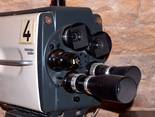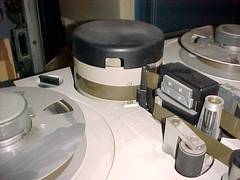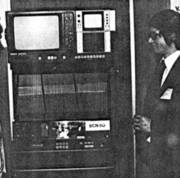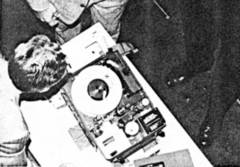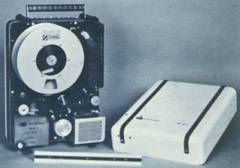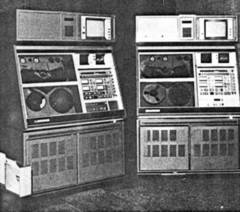Zum Auffrischen und Erinnern . . . .
. . . sind diese Seiten hier gedacht, denn viele wissen nicht mehr oder noch nicht, wie es damals angefangen hat und wie das wirklich funktioniert mit dem Fernsehen, den Kameras, den Videorecordern, den Tonband- und den Magnetband- geräten aus alter Zeit. Viele Bilder können Sie durch Anklicken vergrößern.
Dieser Report / Vergleich von 1975 betrifft schon die letzte Generation der analogen Spulengeräte.
Die VTRs (Video Tape Recorder) mit Schrägspurtechnik
Television stations throughout the world have continued to increase their reliance on video-tape recording as a means of bringing programs to their audiences in a smoother, more efficient manner. This is quite evident when one considers that many prime-time movies are copied on tape before airing to facilitate commercial inserts and simplify equipment scheduling.
The use of very expensive and complex quad cart machines for fast paced station breaks and commercial spots is another indication of this trend. The most prevalent type of VTR assigned to primary studio applications is the quadruplex format machine, of which more than 8,000 are now in use. To date, all attempts by other VTR formats to invade the broadcast market have had only limited success, and mostly in peripheral applications.
However, 1975 witnessed the emergence of a new breed of recorders that can best be described as hybrid machines which combine the best features of the quad (high writing speed, short scan length) with some of the benefits of helical formats (long head life, low tape usage).
The recorders, made by three manufacturers, are defined as segmented-scan helical machines because they all divide the TV image into segments (like the quad does), but use a different number of TV lines for each segment or head band. The three recorders are called the IVC 9000, the Echo Science Pilot I and the Fernseh BCN. They are not compatible with each other as each has a different set of geometric parameters and dissimilar electrical operating characteristics.
The IVC 9000, which is also sold by Thomson-CSF and Rank Cintel, was first introduced at the Montreux conference in 1973 and has been to the major broadcast conventions since. Over 60 of these machines are now in use. Both the Fernseh BCN and the Arvin/Echo Pilot I VTRs were shown at last year's Montreux Symposium in May 1974, and elicited considerable interest among broadcast representatives at that conference.
While these three recorders show some similarity in design philosophy, they are different enough to require separate descriptions of their tape formats and operating features.
1975 - Bosch-Fernseh BCN 20 / BCN 40/50 mit 1" tape
This recorder was developed to meet European LIVE journalism requirements and to serve as a mobile or portable VTR for program acquisition away from the studio. The recorder is a segmented helical machine using two heads, and one-inch tape. It comes in portable, mobile or studio configurations, with the smallest package (BCN 20) weighing 20 kilos (44 lbs.) without batteries or tape. The studio units (BCN 40 and 50) are in console form and can include overtransport monitoring facilities.
The track pattern on the 1" CRO2 tape includes one video track, two program audio tracks, an auxiliary audio track that can serve as a cue or address code track and a control track. Longitudinal tape speed on the BCN series is 24.3 cm/sec (9.5 ips), and this gives a 52 minute recording time on the portable. The console units which accept larger reels can provide up to 95 minutes of record or playback time. Head writing speed is 24 m/sec (950 ips). The video headwheel has two video heads, 180° apart, and two erase heads for "flying erasure" to accommodate editing needs.
The SECAM and PAL image are segmented into even 52 line segments, with 6 tracks forming one field. The NTSC version will use an odd segmentation of 5 tracks per field. A line-by-line autochroma eliminates or minimizes head banding.
As far as video and audio performance goes, the BCN units shown at Montreux and later in Darmstadt, showed third and fourth generation copies that were airworthy. Video performance specs on the European standards, with a 5 MHz bandpass were just slightly lower than quad specs. Audio specs for the two high quality channels using Dolby A correction were at broadcast levels. The BCN unit has not yet been demonstrated on the NTSC standard, however their engineering staff have studied the differences and are confident that the NTSC version of the BCN will meet domestic broadcast requirements.
Arvin/Echo Pilot 1 mit 1" tape
This VTR is not exactly a newcomer to television, having been shown in NTSC versions at some pre-75 NAB shows. Echo Science (formerly Westel) has been building segmented helical recorders for instrumentation and military applications for many years. Recently Arvin acquired this company and a new emphasis was put on developing a new broadcast version of their wideband airborne VTRs. Echo also chose to introduce their Pilot I recorder at Montreux as a contender for the European LIVE journalism market.
This recorder is a two-head, segmented-scan machine using 1" tape, however with a longitudinal tape speed of 38.1 cm/sec (15 ips) and a head-write rate at 37.3 m/sec (1470 ips), its tape geometry is quite different from the BCN. There is, therefore, no interchange-ability between these two 1" machines.
The Pilot I also comes in portable and studio versions. The backpack unit weighs 17 kilos (37.4 lbs.) and permits 30 minutes of recording while the studio unit, which can have a full complement of waveform and picture monitoring equipment over the console version VTR, accommodates 60 minute tape reels. Track geometry on the Pilot I is similar to the BCN, with a video track, two program audio channels, a cue/address code channel, and a control track. Special features claimed for the Pilot I signal system are: super highband mod/demod, pilot carrier color correction, color edit framing and dropout compensation. Video specs equal or superior to quad recorders are achieved with normal Gamma Ferric Oxide (Fe203) tape. Audio specs are also to broadcast quality levels. Multiple generation recordings produce good results.
The IVC 9000 with 2" tape
As far as broadcast applications are concerned, the IVC 9000 was the first segmented helical machine that attracted industry attention to this format. The 9000 was primarily designed as a program originating VTR. It was introduced in its PAL/SECAM configuration in Europe at Montreux 73, and subsequently in an NTSC form at the Fall Conference of the SMPTE the same year.
The 9000 is a segmented-scan, two head helical machine using 2" tape. Head writing speed is 38 m/sec (1500 ips), which allows the use of super highband (9-12 MHz) for the carrier and deviation frequencies. Tape longitudinal speed is 20.3 cm/sec (8 ips) giving over two hours of playing time on a 26.7 cm (10.5 in.) reel. Track geometry on the tape consists of one video track, and three audio tracks (2 program, one cue) along the top edge. A control track and separate address code track are along the bottom edge of the tape. This VTR is also called the Rank Cintel 9000, or the Thomson-CSF TTV 3500.
The 9000 comes in a console configuration with a monitoring bridge on top that can hold picture monitors or associated equipment. Waveform monitoring and the editing system is integral with the control panel on the right hand side of the VTR.
The 9000 uses two long life, hot pressed ferrite heads, that can give 3000 hours of service before replacement. The head drum also carries the flying erase head. Video and audio performance specs are equal or superior to current quad recorders, and this is achieved with normal (non CRO2) longitudinally oriented two inch tape. Tape longevity is also improved by constant tension spooling through the use of vacuum columns, and a vacuum collar keeps the tape away from the scanner during standby modes.
SEGMENTED HELICAL VTR COMPARATIVE CHART
Please notice: this chart is an early one and the lifetime of the scanner of BOSCH BCN recorcders have been increased to 2500 hours. Head warranty was increased to 1500 hours.
| TECHNICAL | BOSCH/FERNSEH | ARVIN/ECHO | IVC/RANK/THOMSON |
| SPECIFICATION | BCN | PILOT I | 9000 |
| TAPE WIDTH | 25.4 MM/1.0 INCHES | 25.4 MM/1.0 INCHES 50.8 | MM/2.0 INCHES |
| TAPE SPEED | 24.3 CM/9.5 IN./SEC. | 38.1 CM/15.0 IN./SEC. | 20.3 CM/8.0 IN./SEC. |
| HEAD SPEED | 24.0 M/950 IN./SEC. | 37.3 M/1470 IN./SEC. | 38.1 M/1500 IN./SEC. |
| RECORD TIME | 52/95 MINUTES | 30/60 MINUTES | 120 MINUTES |
| SCAN ANGLE | 14.3 DEGREES | 19.5 DEGREES | |
| SCAN LENGTH | 80 MM/3.14 INCHES | 133.2 MM/5.24 INCHES | |
| SCAN SEGMENTS | NTSC - 5/SECAM/PAL -6 | NTSC - 5/SECAM/PAL - 6 | |
| PROGRAM AUDIO | TWO TRACKS | TWO TRACKS | TWO TRACKS |
| CUE AUDIO | ONE TRACK | ONE TRACK | ONE TRACK |
| ADDRESS CODE | ONE TRACK | ||
| SIGNAL SYSTEM | HIGHBAND | SUPER HIGHBAND | SUPER HIGHBAND |
| VIDEO S/N | PAL 43dB | PAL 45 dB, NTSC 47 dB | |
| DIFF. GAIN | 4 PER CENT | 4 PER CENT | |
| DIFF. PHASE | 4 PER CENT | 4 PER CENT | |
| K-FACTOR | 2T SIN2 PULSE 1 % | ||
| MOIRE | PAL -35 dB | PAL -40 dB, NTSC -50 dB | |
| TBC ERROR | ± 2.5 NANOSEC. | ± 2.5 NANOSEC. | |
| AUDIO S/N | 55 dB/DOLBY 65 dB | 55 dB | |
| FLUTTER & WOW | 0.1% PEAK | 0.15% PEAK | |
| TAPE TYPE | CRO2 | Fe2O3 | Fe2O3 |
| HEAD WARRANTY | 300 HOURS | 1500 HOURS |

